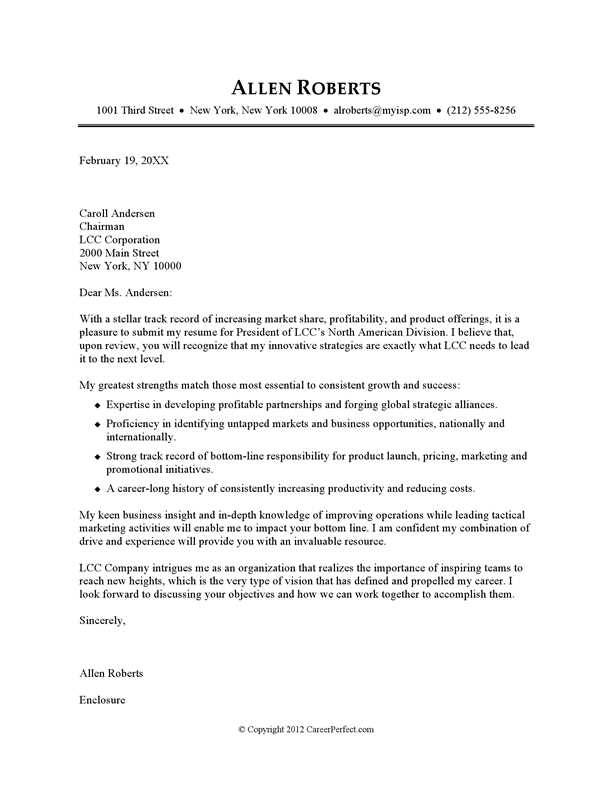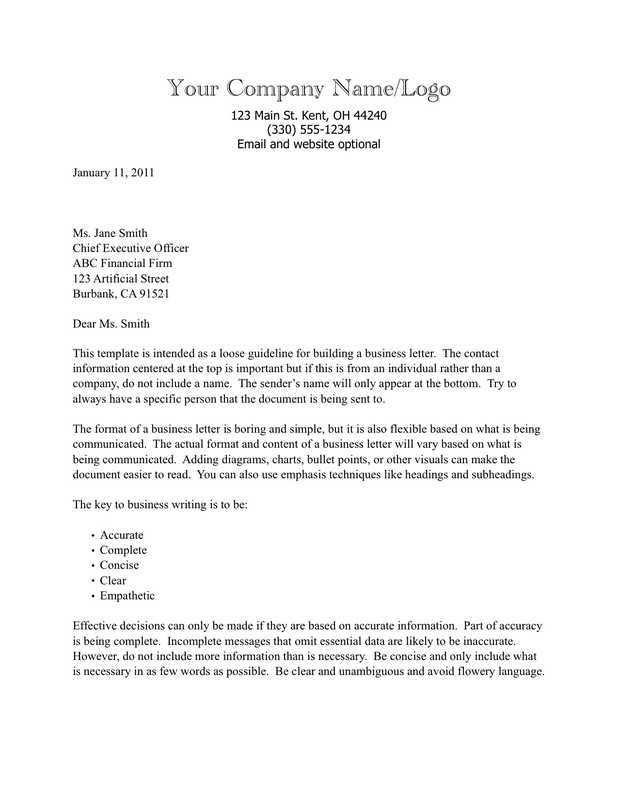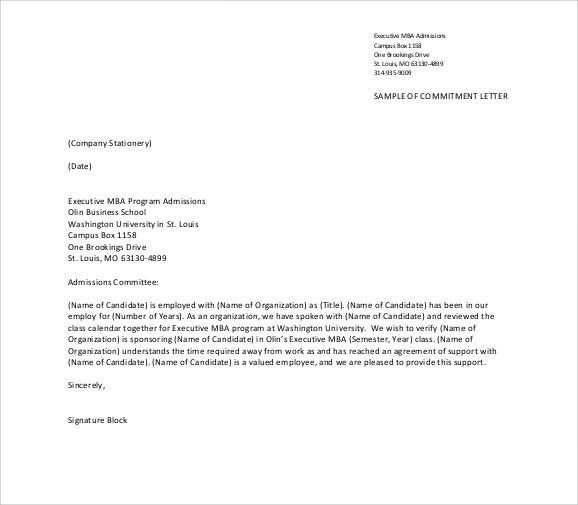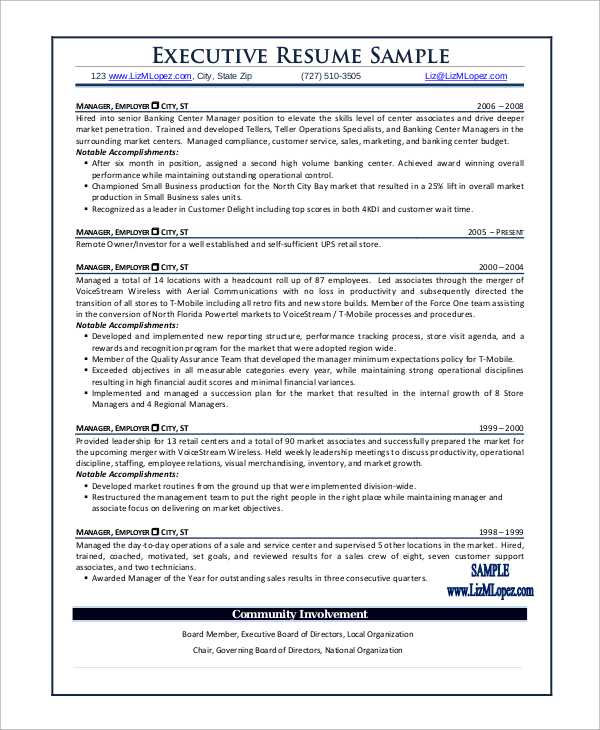Professional Executive Letter Template for Business Communication

Clear and well-structured communication plays a crucial role in business interactions. Whether addressing clients, colleagues, or partners, the right format and tone can leave a lasting impression. Crafting professional correspondence requires attention to detail, clarity, and a strategic approach to ensure the message is effectively conveyed.
In this section, we will explore the essential components of formal written communication in the corporate world. By understanding the core elements and the best practices for crafting these documents, professionals can enhance their credibility and establish stronger connections within their industries.
Personalization is key in maintaining a professional yet approachable tone. Additionally, using the right format can streamline the writing process, making it easier to focus on the message itself. By applying these principles, anyone can elevate their business communication to a higher level.
Executive Letter Template Overview
In the corporate world, structured communication is essential for conveying messages in a professional and effective manner. A well-organized format helps ensure clarity, making it easier for recipients to understand the purpose of the message. By following a proven framework, you can create documents that look polished and authoritative, while still being clear and concise.
The following elements are typically included in formal business communication:
- Header: Contains the sender’s details, date, and recipient information.
- Introduction: Briefly introduces the purpose of the communication.
- Body: The main content where the message is articulated, often broken into clearly defined sections.
- Conclusion: A closing statement that reinforces key points and provides any required next steps.
- Signature: The closing signature of the sender, often accompanied by a title or position.
Each section plays a distinct role in ensuring that the message is both professional and effective. Whether the goal is to request action, deliver important information, or build a relationship, following a well-established format can make a significant difference in how the communication is received and understood.
Key Elements of an Effective Letter
For any formal written communication to be impactful, certain components must be carefully crafted to ensure clarity and professionalism. Each section serves a unique purpose, and understanding how to structure them will result in a message that resonates with the recipient and achieves its intended goal.
Essential Components of Professional Communication

- Clear Purpose: The message should have a well-defined objective, whether it’s requesting action, providing information, or offering feedback.
- Concise Language: Use direct, easy-to-understand language while avoiding unnecessary jargon.
- Proper Formatting: Structure the content logically, with clearly separated sections to enhance readability.
- Appropriate Tone: Maintain a tone that is both professional and respectful, tailored to the recipient and the situation.
Additional Considerations for Strong Communication
- Personalization: Address the recipient by name, and tailor the message to their needs or concerns to create a more engaging communication.
- Actionable Next Steps: Clearly outline any actions required from the recipient, leaving no ambiguity about expectations.
- Polite Closing: End with a courteous statement that reinforces professionalism and strengthens the relationship.
Incorporating these key elements will help create formal communications that not only convey the intended message effectively but also foster positive professional interactions.
How to Personalize Your Executive Letter
Personalizing formal correspondence is key to making a meaningful connection with the recipient. Tailoring the content ensures that your message resonates, builds rapport, and demonstrates attentiveness. A personalized approach shows that the message is not generic and is specifically directed toward the individual or organization in question.
To effectively personalize your communication, consider the following elements:
| Element | Personalization Tip |
|---|---|
| Salutation | Use the recipient’s full name or appropriate title to establish respect and a formal tone. |
| Opening Paragraph | Reference a recent interaction, shared experience, or the recipient’s specific role to make the introduction relevant. |
| Main Content | Address the recipient’s unique concerns, needs, or interests, and align your message to their specific context. |
| Closing | End with a statement or call to action that directly relates to the recipient’s situation or expectations. |
By implementing these strategies, you can enhance the effectiveness of your communication, ensuring that it feels both professional and specifically crafted for the reader.
Common Mistakes to Avoid in Executive Letters

Even the most experienced professionals can make missteps when crafting formal written communication. Small errors can undermine the message and potentially damage the sender’s credibility. It is essential to be mindful of common mistakes to ensure that the document remains professional, clear, and effective in achieving its purpose.
Here are some typical mistakes to avoid:
- Vague Purpose: Failing to clearly state the purpose at the beginning can confuse the reader and make it difficult for them to understand the action required.
- Overly Complex Language: Using jargon or overly complex terms can alienate the reader. Simplicity and clarity are key in formal communication.
- Ignoring the Audience: Not tailoring the tone and content to the recipient can lead to a lack of engagement. Always consider the reader’s perspective and position.
- Inconsistent Formatting: Inconsistent layout, such as mismatched fonts or irregular spacing, can make the document appear unprofessional.
- Missing Details: Failing to include important details, such as deadlines, contact information, or necessary instructions, can cause confusion or delay.
- Unclear Closing: Ending the communication abruptly or without a clear call to action can leave the reader uncertain about the next steps or expectations.
By avoiding these common mistakes, you can improve the effectiveness and professionalism of your formal communications, ensuring that your message is both clear and impactful.
Formatting Tips for Professional Letters
Proper formatting is crucial for making formal communication look polished and credible. The way a document is structured can influence how the message is received and whether it appears organized and trustworthy. A well-formatted document not only improves readability but also helps establish professionalism.
Key Aspects of Formatting
- Consistent Margins: Ensure uniform margins on all sides (typically 1 inch) to give the document a balanced, neat appearance.
- Readable Font: Use a clean, professional font like Arial, Times New Roman, or Calibri, in a readable size (11-12 pt).
- Clear Section Breaks: Separate different sections with appropriate spacing, such as between the introduction, body, and conclusion, to make the text easier to follow.
- Alignment: Left-align the text for a uniform appearance. Avoid centering the main body of the text, as it can reduce readability.
Additional Formatting Guidelines

- Use of Bold and Italics: Bold headings or important points to draw attention, and use italics sparingly to emphasize specific terms or phrases.
- Signature Block: Leave space for the sender’s signature and contact details at the end of the document, creating a professional closing.
- Proofreading: Before finalizing the document, double-check for any formatting inconsistencies or errors, such as incorrect font sizes or spacing issues.
By following these formatting tips, you can enhance the clarity and professionalism of your correspondence, ensuring that it has the desired impact on the recipient.
Best Practices for Strong Closing Statements
The closing of a formal communication plays a significant role in leaving a lasting impression. A well-crafted ending not only reinforces the key message but also guides the recipient on the next steps. A strong conclusion helps ensure clarity and encourages a positive response or action from the reader.
Key Elements of a Powerful Closing
- Summarize Main Points: Briefly restate the key purpose or request, ensuring the reader understands the main objective.
- Call to Action: Encourage the recipient to take the next step, whether it’s scheduling a meeting, responding to a question, or completing a task.
- Offer Gratitude: Show appreciation for the recipient’s time, consideration, or any previous collaboration to build goodwill.
- Professional Tone: Maintain a respectful and formal tone, even when expressing a sense of urgency or follow-up.
Examples of Effective Closings
- Looking forward to your response: Ideal when you need a reply or action from the reader.
- Thank you for your attention to this matter: Shows appreciation and reinforces the importance of the communication.
- I am available for further discussion: Invites continued communication and suggests openness for future engagement.
Incorporating these practices will help you create closing statements that are clear, respectful, and action-oriented, ensuring a professional and impactful conclusion to your formal communication.
How to Use Templates for Efficiency
Utilizing pre-designed structures can save time and ensure consistency in formal communication. Templates allow you to focus on the content, without having to spend time formatting or recreating standard elements for each new message. By leveraging such tools, you can streamline your workflow and produce professional documents more efficiently.
Here are some ways to make the most of templates:
- Customize for Specific Needs: Modify the pre-made format to suit your specific purpose, whether it’s a formal request, an update, or a follow-up.
- Save Time: With a consistent structure in place, you can quickly adapt the template for each new communication, reducing the time spent on formatting.
- Ensure Consistency: Using the same layout across multiple messages ensures that your correspondence maintains a uniform appearance, which can help build a professional reputation.
- Reduce Errors: Templates with pre-built fields and sections help eliminate mistakes in formatting, ensuring that important information is never overlooked.
By incorporating templates into your communication process, you can enhance both your efficiency and the quality of your documents, allowing you to focus more on the substance of your message rather than the layout.